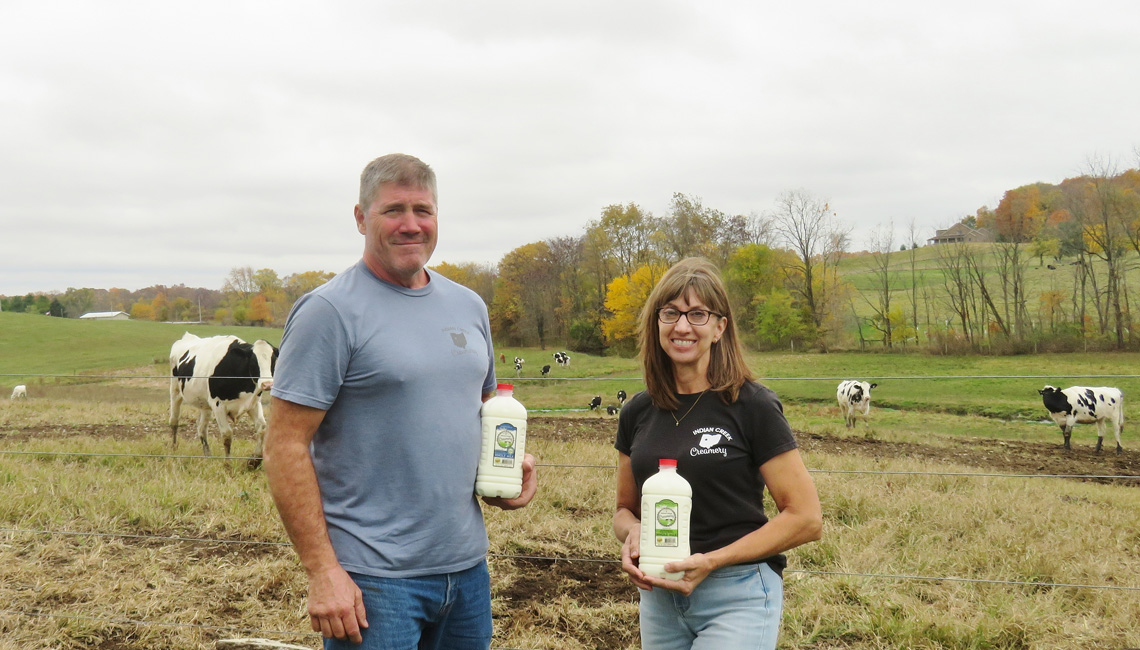When Colleen Jackson instructed her children’s homeschooling group in the early 2000s, she prepared a lesson featuring milk straight from the Holstein cows lolling in the pasture on her family’s 180-acre dairy farm near DeGraff.
“I scooped the cream off the top of the milk, then put it in a jar with some clean marbles and let the kids shake the jar,” she recalls. “They turned the cream into butter.”
She didn’t know it then, but Colleen and her husband, Ray, would later carve their own niche in Ohio dairying in 2019.
Like many dairy farmers in recent years, the Logan County Electric Cooperative members found themselves struggling with high production costs and low milk prices. Ray helped keep the farm afloat by working for a bovine genetics company, but things were tough. Faced with losing the farm and the way of life they love, Ray and Colleen converted an outbuilding into a licensed creamery named for the stream that crosses their land, and Indian Creek Creamery was born. They began producing and bottling non-homogenized milk crowned with a layer of cream, wagering that consumers would thirst for their minimally processed product.
“We started the creamery because we needed to be able to sustain our farm and pay our bills,” Colleen says. “We also wanted people to know what real milk tastes like.”
The Jacksons know a thing or two about “real milk” because they both grew up on dairy farms. He is from the Wellington area, and she was raised near Urbana. They met at Ohio State, where Colleen majored in business and Ray, a self-described “cow nerd,” studied dairy science. After marrying in 1990, they rented acreage from Colleen’s father until Ray found an affordable farm about 5 miles north of DeGraff. Though run-down, it had a functional milk house and an early 1900s farmhouse, which they moved into in 1995.
 Today, Ray and Colleen have 140 Holsteins, and keeping the herd happy and healthy is their top priority. They grow their own crops for feed; use sand as dairy cow bedding to cushion the stalls (they say it’s the gold standard); and maintain a free stall barn where the cows can come and go as they please. “The single biggest thing we do for our cows’ comfort is let them leave the barn and go outside into the pasture,” Ray says. “They enjoy the pasture so much that they’ll even lay down in the snow.”
Today, Ray and Colleen have 140 Holsteins, and keeping the herd happy and healthy is their top priority. They grow their own crops for feed; use sand as dairy cow bedding to cushion the stalls (they say it’s the gold standard); and maintain a free stall barn where the cows can come and go as they please. “The single biggest thing we do for our cows’ comfort is let them leave the barn and go outside into the pasture,” Ray says. “They enjoy the pasture so much that they’ll even lay down in the snow.”
The Jacksons breed their cows via artificial insemination, and because cows instinctively seek a quiet place to give birth, they put expectant moms into a special “maternity ward” pen three weeks before they’re due to calve. Getting the newborn calves off to a good start is all in a day’s work for Colleen. “I hand-feed them with either bottles or buckets for two months,” she says.
Ray and Colleen milk 70 cows daily and process the raw milk into Grade A milk that’s sold in half-gallon, BPA-free plastic bottles. They only offer three products: regular whole milk, chocolate milk made from a recipe Colleen developed, and A2/A2 whole milk.
Cows have two variations — A1 and A2 — of the gene that forms protein in milk, and Indian Creek Creamery’s A2/A2 milk comes solely from DNA-tested cows possessing two A2 genes. Since it requires laboratory analysis and separate processing, A2/A2 milk has a premium price, yet is gaining popularity because many people who have difficulty digesting A2/A1 milk can drink the A2/A2 version.
Their method preserves the flavor of raw milk, but they never homogenize because, Colleen explains, “We provide milk as nature intended, with nothing added and nothing taken away.” Although butterfat naturally floats on raw milk, large-scale milk producers both fragment the fat to make a uniform liquid (homogenization), and also remove some of the butterfat to meet federal standards. “Typical whole milk is 3.25% butterfat,” notes Ray. “Our milk tastes richer because it’s 4.2% butterfat.”
The creamery’s initial production run was just 83 half-gallons, but now the Jacksons turn out 4,000 bottles weekly and deliver them to customers ranging from chefs and baristas in Cincinnati and Columbus to independent grocers and specialty shops in small towns. Before homogenization took hold in the 1920s, every bottle of milk had a top ring of cream, so when Ray gave milk samples to prospective buyers, he had to teach them something that their great-grandparents did routinely: shaking the bottle to mix in the cream. His personal touch paid off. “People love it when a farmer shows up, looks them in the eye, and tells them the milk is so fresh that it was in the cow the night before.”
To find locations that sell Indian Creek Creamery products, visit www.indiancreekcreamery.com.









